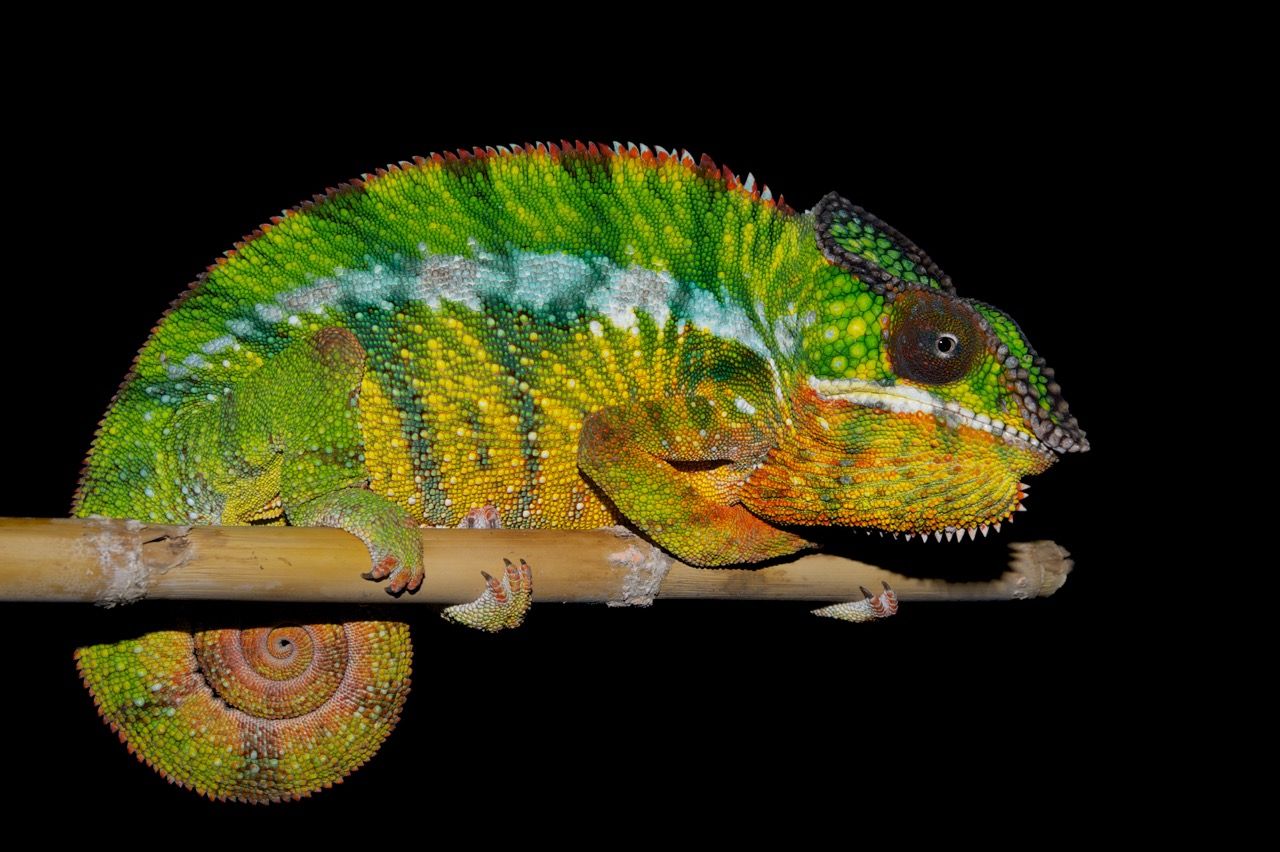Chameleons possess the remarkable ability to change colors for communication and temperature regulation. They achieve this through specialized cells in their skin called chromatophores.
Understanding the color-changing abilities of chameleons is a subject of fascination and scientific study. These reptiles are famous for their vivid display of colors, which is not only a means of blending with their environment but also a way to express their behavioral states.
Their skin contains various layers of specialized pigment cells that contract or expand to mix colors, much like a painter combines paint on a palette. These changes can occur within minutes or even seconds, reflecting their reaction to light, mood, or the presence of other chameleons. This dynamic feature enhances their survival, making them one of nature’s most intriguing creatures to observe and study.

Credit: fastercapital.com
The Enigma Of Chameleon Coloration
Chameleons are famous for their color-shifting skills. But why do they change colors? The answers are as striking as the chameleons themselves. These mesmerizing reptiles have a unique place in the animal kingdom. With their color-changing abilities, they are often symbols of adaptability and transformation. But the science behind their shifting hues is even more fascinating than the myths.
Secrets Behind Their Vibrant Wardrobe
A chameleon’s skin is a marvel of nature. It holds special cells called chromatophores. These cells are like tiny bags filled with different colors. When chameleons want to change color, they stretch or relax their skin. This action spreads or mixes the color bags.
- Chromatophores: These are the topmost layer cells containing yellow and red pigments.
- Iridophores: Below the chromatophores, these reflect light and create blues and greens.
- Melanophores: Found even deeper, these cells can darken the chameleon’s skin.
Factors Influencing Color Transformation
Chameleons change color for many different reasons. It’s not just about hiding from predators or hunting for food. Their emotions play a big part too.
| Factor | Influence on Color Change |
|---|---|
| Temperature | Cooler for warmth, darker to absorb heat. |
| Light | Changes intensity to suit sunlight levels. |
| Mood | Bright colors for showing off, dark for stress. |
| Health | Indicates if they feel ill or healthy. |
| Mating Signals | Male chameleons show vivid patterns to attract mates. |
Remember, these factors often combine to dictate a chameleon’s color. This makes each change a unique and fascinating process.
Science Of Chameleon Chromatics
Chameleons are nature’s masters of disguise. These amazing creatures change color to hide from predators, impress potential mates, or regulate their body temperatures. But what is the science behind their color-changing abilities? Let’s delve into the fascinating world of chameleon chromatics and uncover the secrets beneath their vibrant skins.
Understanding Skin Structure
The secret to a chameleon’s color change lies in its unique skin structure. Their skin is made up of several layers, and each plays a role in their ability to shift hues. Below the surface layer, special cells known as chromatophores are found.
Role Of Chromatophores In Dynamic Hues
Chromatophores are pigment-containing cells that stretch and contract to reveal new colors. These cells come in different types:
- Xanthophores and erythrophores: contain yellow and red pigments.
- Iridophores: reflect light, creating iridescent blues and greens.
- Melanophores: have dark pigments that can make the chameleon appear darker.
This complex system allows chameleons to display a rainbow of colors. Below, a simple table outlines how these chromatophores work:
| Chromatophore Type | Color | Function |
|---|---|---|
| Xanthophores | Yellow | Color display |
| Erythrophores | Red | Color enhancement |
| Iridophores | Blues/Greens | Light reflection |
| Melanophores | Dark hues | Shading and darkening |
Beyond Camouflage: The True Purpose
Think chameleons change colors simply to hide? Think again! These remarkable reptiles use their color-changing skin to communicate, regulate their body temperature, and even show off their mood. Let’s explore the amazing abilities of chameleons beyond the basic need to blend in.
Communication Through Color
Chameleons are masters of messaging through their skin. Colors and patterns can signal all sorts of things:
- Warning: A chameleon might turn a vivid color to ward off rivals.
- Courting: Males change to bright hues to attract females.
- Submission: A chameleon may display a dull color to avoid conflict.
Temperature Regulation And Mood Display
Color helps chameleons control body heat and show feelings. They darken their skin to soak up warmth when it’s cool, and lighten it to reflect heat when it’s hot. But that’s not all!
| Mood | Color Indication |
|---|---|
| Relaxed | Green or blue shades |
| Agitated | Brighter, intense colors |
| Stressed | Dark, dull colors |
Each color change tells a different story, a silent language that says so much about what a chameleon is feeling or how it’s dealing with its environment.

Credit: scitechdaily.com
Spectral Mastery: How Chameleons Shift Shades
Chameleons are artistic masters of disguise. These creatures can change their skin color. They blend with their surroundings. This skill helps them avoid predators. It also aids in regulating their body temperature.
Color change serves as a form of communication among chameleons too. These reptiles can convey feelings like fear or anger. They can also show readiness to mate through their color patterns.
Mechanical Nuances Of Color Change
Chameleons have unique layers in their skin. The top layers are transparent. Under them are layers with special cells called chromatophores.
- These cells have different pigments.
- When chameleons change color, these cells expand or contract.
- This process alters the light reflection.
- It changes the chameleon’s color visibly.
Light Interference And Reflection
Some chameleons also use light to change color. They have nanocrystals in their skin. These reflect light in different ways.
This is due to a phenomenon called structural coloration.
- When light hits these nanocrystals, it interferes with other light waves.
- This creates different colors depending on the angle and space between the crystals.
- Chameleons can actively tune these nanocrystals.
- They alter the distance between them.
- This shifts the reflected wavelength of light.
- It leads to rapid and dramatic color changes.
Observing Chameleons In Action
Chameleons are nature’s master magicians, boasting a fascinating ability to change colors. This incredible talent not only captivates animal enthusiasts but also intrigues scientists. To truly appreciate this wonder, one must observe chameleons closely as they transform with remarkable agility and grace. Their skin acts like a live canvas, reflecting their emotions, temperature, and the very essence of survival. Witnessing a chameleon’s color change is like watching a painter blending hues on a palette – subtle yet dramatic. Let’s discover how they achieve this feat.
Capturing The Color Change Process
Tracking chameleon color changes is a dynamic experience. Video technology allows for detailed observation. Here’s the process:
- Chameleons willingly adjust colors according to mood, temperature, and light.
- Special skin layers work together to alter their appearance.
- Chromatophores, special cells in the skin, stretch and shrink, mixing pigments like a painter mixes colors.
Photography captures these transitions, offering a glimpse into the chameleon’s secretive world.
Documenting Distinctive Patterns And Triggers
Chameleons possess a spectrum of patterns and colors. Documentation involves:
- Ongoing observation under various conditions.
- Identifying patterns related to environmental changes.
- Noting behavioral triggers such as stress or the presence of other chameleons.
Structured research helps us understand the why behind their vibrant displays.
Chameleons teach us the art of adaptation through their impressive skin theatrics. Observing these creatures in action provides valuable insights into the natural world’s complexities. Their color changes, more than a mere spectacle, are a mode of communication and survival.
Conservation And Future Research
Imagine a world where creatures blend seamlessly into their surroundings. Chameleons master this art with their remarkable color-changing abilities. But, why do these fascinating reptiles change colors? Mainly for communication and temperature regulation. Now, let’s delve into how we can protect these unique creatures and what future technologies their talents might inspire.
Preserving Chameleon HabitatsPreserving Chameleon Habitats
Safeguarding the environment of chameleons is vital. Here are key steps:
- Stop habitat destruction: This means no more cutting down forests where chameleons live.
- Legal protection: Create laws to save chameleon homes.
- Community efforts: Teach locals to keep chameleon habitats safe.
Emerging Studies On Color-changing Technology
Chameleon skills inspire scientists. They think of new gadgets that can change colors!
Researchers work hard to crack the code of chameleon magic. They study their skin to make cool new tech.
| Study Area | Purpose | Potential Use |
|---|---|---|
| Chameleon Skin Structure | Understand Mechanics | Develop Camouflage Material |
| Color-changing Process | Replicate Technique | Create Dynamic Displays |

Credit: medium.com
Frequently Asked Questions Of What Color Changing Abilities Do Chameleons Have?
What Is The Chameleon’s Colour Changing Ability?
A chameleon’s color change is a response to mood, temperature, and communication, primarily facilitated by special cells, called chromatophores, that contain different pigments in layers within their skin.
What Are The Abilities Of A Chameleon?
Chameleons possess distinct abilities such as 360-degree vision, rapid color-changing skin, and long, sticky tongues for catching prey. Their feet grip branches securely, and they expertly blend into surroundings for camouflage.
What Is The Chemistry Behind Chameleons Changing Color?
Chameleons change color through specialized cells, called chromatophores, in their skin. These cells expand or contract to mix pigments and reflect light differently, resulting in color changes that help with communication and temperature regulation.
How Do Chameleons Change Color Crystals?
Chameleons change color by adjusting special cells with pigment, known as chromatophores. These cells contain tiny crystals that reflect light differently when the chameleon’s muscles expand or contract them, altering the reptile’s coloration.
Conclusion
Chameleons are truly remarkable with their color-changing prowess. This adaptation is key for camouflage, communication, and temperature regulation. Understanding these creatures enhances our appreciation of nature’s intricacies. Let’s continue to marvel at chameleon wonders, fostering a deeper connection with the animal kingdom.

